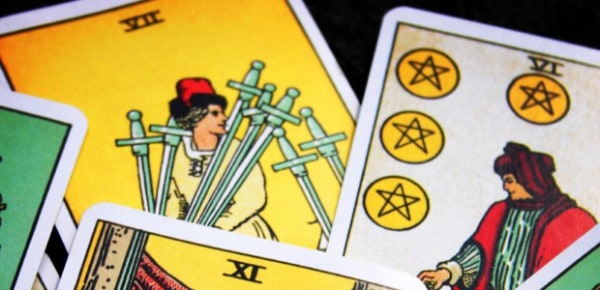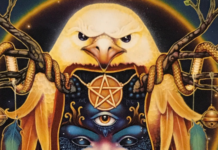 When I bought my first tarot deck, I did not immediately connect to the Queen of Pentacles pictured on the Universal Waite box. She was calm and contemplative. She was still, and I was a 17 year old woman in motion.
When I bought my first tarot deck, I did not immediately connect to the Queen of Pentacles pictured on the Universal Waite box. She was calm and contemplative. She was still, and I was a 17 year old woman in motion.
I trusted that the decision to engage in tarot would awaken a journey of discovery, but remained fixated with the legacy of a great-grandmother who taught English. Grammy was the Queen of Pentacles, connected to teaching, but the lessons of reflecting on tarot through poetry and more have been part of my educational adventures.
It took time for me to mature, until part of me became that queen who holds a bold yellow pentacle in her lap, studying it in a rose garden. Ten years after I bought that first deck, tarot fuelled a book-length collection of poems for my Masters in Poetry (MFA). Tarot quickly came to mean reflection, grounding, and the seeking and surfacing of definition or identity, traits tied to the Queen of Pentacles, a keeper of the psyche’s hearth.
Tarot learners begin as Pages
Pages are members of the tarot court, 16 different cards, with four cards for each suit. The Pages are like students, and are associated with messengers.
One well-known strategy for learning about tarot and its 78 cards, is to recognize it as a messaging system. Journal about the cards one at a time, and keep records of tarot readings in a tarot journal. Tarot writing, whether for poetry,1 blogs or journals, is not unlike the creation and maintenance of that rose garden on the Queen of Pentacles’ card. A powerful aspect of the discipline of tarot is that each reader brings their own experience and imagination to their decks, just as writers do in their work.
To arms: Growing into Knighthood
While the cards are meant to work intuitively, they do not always readily speak to everyone. Like the Knights of the court cards, a calling to learn tarot often accompanies several methods of discipline.
There are many ways to train to be a tarot practitioner with the aid of the written word. Numerous books translate the meanings of each image and how they connect to one another. Tackling the complexities of tarot takes a determined personality, preferably one with extensive patience, tirelessness, and a supportive community.
Learning tarot can be immensely rewarding, offering new perspectives to those who use the cards themselves and those who seek answers from them. Like a knight competing at a tournament, tarot can often catch you off-guard and teach you new skills. It can make you adaptable or more perceptive, whether you explore the art alongside others or alone.
The practice of tarot, like the creative writing which can help deepen understanding of its uses and archetypes, can take a lot of energy. Similarly, as a knight battles and perfects his ability to defend his kingdom, such endeavours take time, revision, and personal awareness and forgiveness.
Tarot Queens look within, and bring communities together
Tarot can act as a centre for communities to gather around. And tarot may remain at the core of personal writing activities as well as writing used for tarot professionals — newsletters, blogs, meetup.com descriptions, communications for local fairs, and more.
A local group I have experienced with queenly personalities who nurture a love of tarot include the Denver Tarot Meetup, and online, groups like Tarotholics Anonymous and Tarot Professionals on Facebook, and Tarot Enthusiasts on LinkedIn.
Queens are not simply nurturers of others, but they arguably have reached a maturity level and status that allows them to look within and establish pockets of community if they choose.
Kings as storytellers
Anyone can share insights from tarot. Piecing together the stories is another endeavour.
The King, the final of the four court cards, in many ways represent the talent of using tarot as a writing and storytelling device. Kings can act with a sense of control, true, but the archetypal king also listens to his people.
When you next begin to journal or write, consider pulling one card at a time and writing their message to you, as if you were their ruler. What does each card want? What does each card think about the kingdom/home you have responsibility for? Are you meeting these responsibilities?
Tarot reading and tarot writing often open into and depict the sacred, the creative, the psychological, and the spiritual. Creative interpretations and imaginative stories or poetry can be about anything. No matter what the cards or the words describe, a strong sense of personal perspective and lifelong influence will be at play.
Identity and the creative process
In dedicating yourself to writing with and about tarot, you are inviting an examination of yourself and those near you. This process is natural to all writing, but seems doubly impactful through the imagery and energy of tarot.
Before I explored the potential of tarot communities, I completed a masters in poetry. Writing a thesis based on my tarot deck forced me to examine my inner landscape. I can return to some of these poems and see within their lines the challenges I faced.
The Queen of Pentacles and I felt more kinship than ever as I wrote my poetry masters. She sat on her throne, but didn’t seem to be in her castle, and perhaps I projected my restlessness on her. I considered the imagery of her garden walls behind her, and the depiction of the castle on the King of Pentacles in a couple of my poems, and castle symbology became a device that my advisor encouraged me to write about.
One short poem that examines the common symbol of castles throughout tarot describes how various people behave around castles, a metaphor for homes or relationships. It ends with a sentiment that we “wish our corners / wore drawbridges.”
It’s been only six years since working on that poetry, and each time we use tarot and write about it, our understanding grows richer. As a graduate student, I had mistaken the Queen of Pentacles’ stillness for resignation. Maybe she had a touch of depression. She felt trapped and hoped for multiple drawbridges, or chances to free herself. The castle with many drawbridges has become an extension of the concept of how some people may want to connect to others, while that poem is now a recollection of my idea of who I was and what I once felt.
- See, “An introduction to writing tarot poetry.” [↩]








